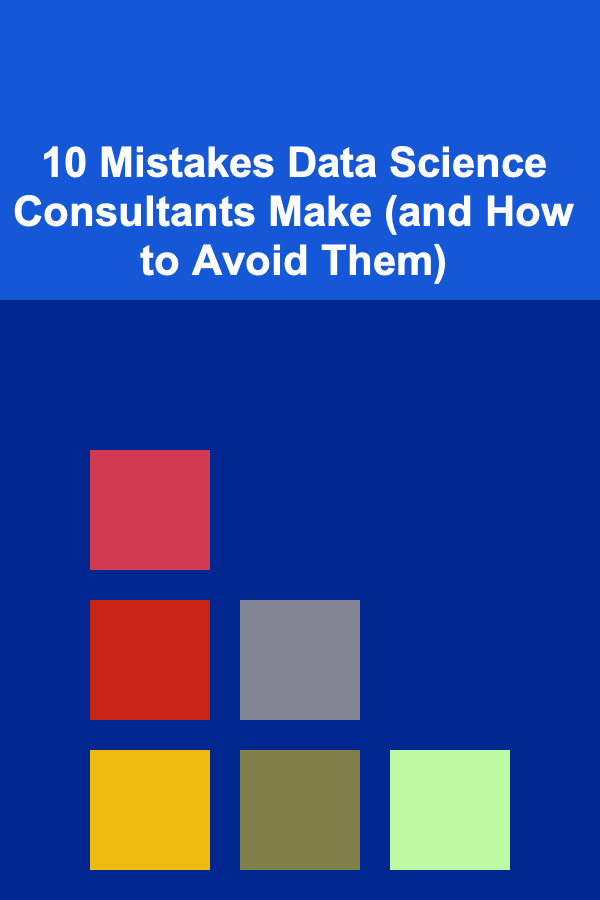
How to Build a Minimum Viable Product (MVP)
ebook include PDF & Audio bundle (Micro Guide)
$12.99$8.99
Limited Time Offer! Order within the next:

In the fast-paced world of startups and tech innovation, the concept of a Minimum Viable Product (MVP) is crucial. It refers to a product that is developed with the minimum set of features necessary to satisfy early adopters, gather feedback, and test core assumptions before investing significant resources into full-scale development. Building an MVP can be the key to achieving success, minimizing risks, and ensuring that you're developing something that resonates with your target audience.
This guide will walk you through the process of building an MVP, from understanding the concept to executing it in a structured way. We'll dive deep into the steps, methodologies, and strategies that will help you create an MVP that is both effective and efficient.
Understanding the Minimum Viable Product (MVP)
Before you dive into building an MVP, it's essential to understand what it is and why it's important. The term "minimum viable product" was popularized by Eric Ries in his book The Lean Startup. The MVP is a concept that originated from the Lean Startup methodology, which encourages creating a product with the fewest features that can be deployed to users for feedback.
An MVP allows you to:
- Test hypotheses: By launching a basic version of the product, you can verify or invalidate assumptions you have about your business or product idea.
- Minimize waste: You avoid spending excessive time, money, and effort on features or designs that might not be needed.
- Focus on core functionality: It ensures you're developing only what is absolutely necessary to solve the problem at hand.
- Validate product-market fit: An MVP helps you measure whether there is a real demand for your product before you fully invest in it.
An MVP is not a prototype or an incomplete version of the final product. It should provide value to users and solve a real problem, but with the least complexity.
The Key Principles of Building an MVP
Building an MVP effectively hinges on understanding and applying the core principles behind it. Here are the foundational ideas that guide the MVP process:
Focus on Core Features
When building an MVP, you need to prioritize. You must select only the features that are essential for solving the core problem of your target customers. Any additional features that don't contribute directly to this should be left for later versions.
Embrace Iteration and Feedback
An MVP is meant to evolve over time. Once you launch your MVP and collect feedback from users, you can make data-driven decisions to refine and improve the product. Continuous iteration is a key part of the MVP philosophy.
Fast Development and Launch
Speed is crucial in MVP development. The goal is to get a product out into the market as quickly as possible, allowing you to test your assumptions and gather real-world data. Focus on building a product that can be deployed swiftly, even if it's not perfect.
Low-Cost Development
The MVP approach is also designed to minimize costs. Rather than spending years developing a product that may not meet customer needs, you can start small, learn, and adjust the direction without investing large sums upfront.
Data-Driven Decision Making
The data you collect from MVP users is invaluable. This data can be used to refine the product, confirm or reject hypotheses, and decide whether to pivot or persevere with the current product direction.
Steps to Build a Minimum Viable Product
Building an MVP can be broken down into several essential steps. While each startup or project may require a slightly different approach, the following steps are a standard framework that can guide your MVP development process.
Step 1: Identify the Problem You're Solving
The foundation of every successful MVP lies in solving a real problem. This step requires careful thought and understanding of the issue you're addressing. Here's how to begin:
- Conduct market research: Understand your target audience, their pain points, and their needs. Speak with potential customers, analyze competitors, and explore trends to identify the most pressing problems.
- Narrow the focus: Don't try to solve multiple problems at once. Identify the single most critical issue to focus on for your MVP.
Step 2: Define Your Target Audience
Knowing who your product is for is essential in building a relevant MVP. Once you've identified the problem, you'll need to understand your target users:
- Create user personas: These are semi-fictional representations of your ideal customers based on market research. User personas help you better understand the motivations, challenges, and behavior of the people you are building the product for.
- Segment your audience: Different users may have different needs. You should identify and prioritize the most valuable user segment for your MVP.
Step 3: Map Out the Core Features
Now that you know the problem you're solving and who your target audience is, it's time to define the essential features of your MVP. At this stage, the goal is to focus only on the must-have functionality that delivers value to users.
- List features: Start by listing all possible features you think the product could have.
- Prioritize features: Rank features based on their importance to solving the core problem. Think about which features are critical for your MVP and which can be postponed for later development.
- Use the MoSCoW method : This method helps you prioritize features by categorizing them into:
- Must have: Essential features for the MVP.
- Should have: Features that would improve the product but are not crucial for the MVP.
- Could have: Features that are nice to have but can be added after the MVP.
- Won't have: Features that are not needed for the MVP.
Step 4: Build the MVP
Once you've identified the core features, it's time to build your MVP. This phase involves actual development and testing.
- Agile development: Adopt an agile approach to MVP development, with iterative cycles that allow you to adjust and improve as you go. Focus on building the basic features first.
- Choose the right tools : Select tools and platforms that enable rapid development. For web-based MVPs, frameworks like Ruby on Rails or Django are popular choices. For mobile apps, React Native or Flutter can help accelerate the development process.
- Use no-code or low-code tools : If you're not a developer, consider using no-code tools like Bubble , Adalo , or Webflow to build the MVP without needing extensive coding knowledge.
Step 5: Test Your MVP
Once your MVP is developed, you need to test it with real users. This is where the feedback loop begins.
- Recruit early adopters: Find people who are willing to test your product. These individuals are usually more open to trying new products and can provide valuable feedback.
- Conduct usability tests: Observe how users interact with the product. Are they able to navigate it easily? Does the product solve their problem? Use this feedback to make adjustments.
- Collect qualitative and quantitative data: Besides feedback, gather data on how users behave with the product. This could be through analytics tools or simple surveys.
Step 6: Gather Feedback and Iterate
Feedback is the lifeblood of the MVP process. After your initial testing phase, it's time to take the data and make informed decisions about how to improve the product.
- Analyze feedback: Look for patterns in the feedback you receive. Which features are users requesting? Are there pain points that are not being addressed?
- Iterate quickly: Based on the feedback, prioritize updates and improvements to your product. Implement changes swiftly to enhance the user experience.
- Decide whether to pivot or persevere: Sometimes, after gathering feedback, you might find that your MVP isn't quite hitting the mark. If that's the case, you may need to pivot, which means shifting your product focus based on what you've learned.
Step 7: Plan for Scale
Once you've refined your MVP and validated it with users, it's time to plan for scaling. The feedback from the MVP phase will guide the development of the full product.
- Evaluate the MVP's success: Did it meet your initial goals? Did you gather enough data to move forward?
- Map out next steps: Plan the full-featured product based on your MVP feedback. Make sure that it solves the core problem while meeting the needs of a broader audience.
- Build for scalability: As you scale, consider technical issues, such as infrastructure and database management, that will support growth.
Common Pitfalls to Avoid When Building an MVP
While building an MVP is a powerful approach, it's not without its challenges. Here are some common pitfalls you should avoid:
1. Overcomplicating the MVP
It's easy to get carried away with adding extra features, but remember, the goal of an MVP is to keep it simple and focused on solving the core problem.
2. Ignoring User Feedback
Without user feedback, your MVP may fail to meet the needs of your target audience. Always prioritize continuous testing and improvement based on user input.
3. Building for Perfection
An MVP is not meant to be perfect. It's meant to be a starting point for learning and refining your product. Avoid the temptation to over-polish it.
4. Neglecting the Marketing Aspect
Even the best MVP won't succeed if no one knows about it. Make sure you have a marketing plan in place to reach potential users and attract feedback.
Conclusion
Building a Minimum Viable Product is an essential process for startups and entrepreneurs looking to validate their ideas with real customers. By focusing on core features, testing early, and using feedback to iterate, you can minimize risk and maximize your chances of success. Remember that the MVP is just the first step in your product journey, and continuous iteration based on user feedback will guide your product toward its final, fully-featured version.
In the ever-changing landscape of technology and innovation, the MVP approach allows you to stay flexible, pivot when necessary, and avoid wasted resources. By following the steps outlined in this article, you'll be well on your way to building an MVP that not only meets customer needs but also paves the way for your product's long-term success.
Reading More From Our Other Websites
- [Sewing Tip 101] Step-by-Step: Setting Up and Threading Your Sewing Machine Like a Pro
- [Home Holiday Decoration 101] How to Decorate Your Entryway for a Welcoming Holiday Spirit
- [Home Cleaning 101] How to Clean and Organize Your Spice Rack
- [Tie-Dyeing Tip 101] Troubleshooting Tie-Dye on Tote Bags: Tips for Even Color, Longevity, and Care
- [Home Security 101] How to Train Your Family to Respond to Home Security Threats
- [Tie-Dyeing Tip 101] Bursting Colors: Tie‑Dye Techniques for Cotton, Silk, and Linen
- [Home Budget 101] How to Refinance Your Home Loan for Better Financial Flexibility
- [Star Gazing Tip 101] Best Infrared Filters for Revealing Hidden Features in Galactic Star Clusters
- [Home Budget Decorating 101] How to Incorporate Vintage Pieces into Your Home Decor
- [Home Storage Solution 101] How to Declutter and Organize Your Wardrobe Like a Pro: The Ultimate Guide to Clothes Storage

How to Choose the Right Office Supplies for Maximum Efficiency
Read More
How to Manage Hazardous Materials Safely in Your Garage
Read More
How to Soundproof a Room with Limited Space
Read More
How to Prepare Your Yard for a Move-Out Inspection
Read More
How to Create Immersive VR Experiences with Unity
Read More
10 Mistakes Data Science Consultants Make (and How to Avoid Them)
Read MoreOther Products

How to Choose the Right Office Supplies for Maximum Efficiency
Read More
How to Manage Hazardous Materials Safely in Your Garage
Read More
How to Soundproof a Room with Limited Space
Read More
How to Prepare Your Yard for a Move-Out Inspection
Read More
How to Create Immersive VR Experiences with Unity
Read More